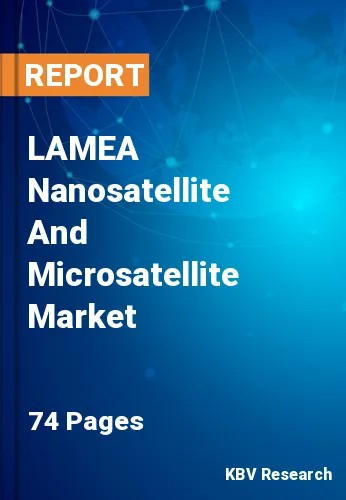The Latin America, Middle East and Africa Nanosatellite And Microsatellite Market would witness market growth of 28.2% CAGR during the forecast period (2022-2028).
It is anticipated that factors such as the smaller size and weight of smallsats in contrast to conventional spacecraft, as well as the rise in the production and launch of CubeSats, will drive the development of the market. In addition, an increase in the need for nanosatellites and microsatellites from the business sector as well as an increase in demand for satellite data are expected to provide attractive growth possibilities for the participants in the market.
Due to their straightforward and expedient manufacturing and design requirements, small satellites are experiencing ongoing technological improvements. Additionally, streamlined development and design are making it possible to include cutting-edge technology like robots and artificial intelligence (AI) in small satellites. These satellites use ultra-high frequency (UHF), visible transmission, and very high frequency (VHF) transmission technologies to boost transfer rates and signal frequency.
Machine learning intelligence on different space exploration platforms is assisting in assuring efficient communications, strengthening coordination for the advancement of a mission, and improving spacecraft reliability. Humanitarian partners and governments, among others, are also likely to receive useful data insights from these satellites. Multiple vertical markets' increasing demand for nanosatellites and microsatellites is expected to fuel market expansion.
The Brazilian Space Agency has a number of joint initiatives with universities, research institutions, nonprofits, third-sector organizations, and private enterprises with outreach courses, and projects. These research projects encompass STEAM (Science, Technology, Engineering, the Arts, and Mathematics) training aimed at primary education and well beyond. These initiatives would also delve into the fields of Space Applications, Astronautics, Astronomy, and Astrophysics.
The Brazil market dominated the LAMEA Nanosatellite And Microsatellite Market by Country in 2021, and would continue to be a dominant market till 2028; thereby, achieving a market value of $167.7 million by 2028. The Argentina market is experiencing a CAGR of 28.9% during (2022 - 2028). Additionally, The UAE market would exhibit a CAGR of 27.9% during (2022 - 2028).
Based on End-Use, the market is segmented into Commercial, Government, Defense & Security and Civil. Based on Application, the market is segmented into Earth Observation/Remote Sensing, Communication & Navigation, Scientific Research and Technology & Academic Training. Based on Mass, the market is segmented into Nanosatellites and Microsatellites. Based on countries, the market is segmented into Brazil, Argentina, UAE, Saudi Arabia, South Africa, Nigeria, and Rest of LAMEA.
Free Valuable Insights: The Global Nanosatellite And Microsatellite Market is Predict to reach $8 Billion by 2028, at a CAGR of 22.3%
The market research report covers the analysis of key stake holders of the market. Key companies profiled in the report include Dauria Aerospace, GomSpace Group AB, ISISPACE Group, Sierra Nevada Corporation (SNC), Spire Global, Inc., AAC Clyde Space, Surrey Satellite Technology Limited (SSTL), The Boeing Company, and Tyvak International
By End-Use
By Application
By Mass
By Country
Our team of dedicated experts can provide you with attractive expansion opportunities for your business.

